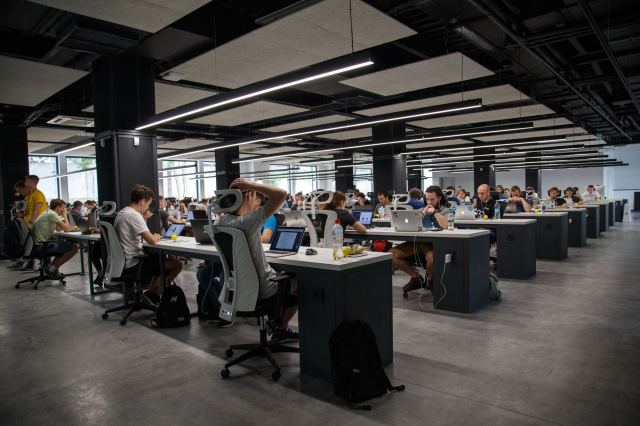Credit: Alex Kotliarskyi

Sadly, there’s no such thing as ‘silence pollution’. We’ve invented any number of mechanical and electronic ways to pollute the environment with noise, but what we can’t do is broadcast the absence of noise.
We have noise cancelling headphones of course, but those have a very limited area of effect. Imagine, however, a device that could generate hush across a wider area – a train carriage, for instance. It would be wonderful: waves of quiet drowning out mobile phones, washing over leaky headphones, imposing silence on people accustomed to imposing their noise on others.
There’d be complaints, of course. Indeed, one can imagine laws might be passed to outlaw the silencing machines – ours is a society that typically places a higher value on ‘freedom to’ than ‘freedom from’.
In the public sphere the last havens of silence are disappearing, actively disapproved of by those who design our shared spaces. Even the libraries have lost their quiet faith – the stern shush of the librarian replaced by inane chat with colleagues and customers.
And then, of course, there’s there’s the definitive shared space of the age – the open plan office.
Amanda Mull of The Atlantic describes the irresistible rise of this abomination:
“If you’re under 40, you might have never experienced the joy of walls at work. In the late 1990s, open offices started to catch on among influential employers—especially those in the booming tech industry. The pitch from designers was twofold: Physically separating employees wasted space (and therefore money), and keeping workers apart was bad for collaboration. Other companies emulated the early adopters. In 2017, a survey estimated that 68 percent of American offices had low or no separation between workers.”
I suspect that most of the remaining 32% cater for enterprises that are too small to need a space big enough to be described as open plan. But even for them there may soon be no escape. ‘Coworking’ facilities in which multiple employers and self-employed people share the same space have become increasingly fashionable – and popular with landlords who can maximise rentable square footage in high demand locations.
In modern psychology, the so-called Big Five personality traits are openness, conscientiousness, extraversion, agreeableness and neuroticism. These are referred to by acronym OCEAN, or alternatively CANOE. OCEAN is the more appropriate, because what our culture considers to be the least desirable personality trait is placed last, while the most desirable, openness, is placed first. Open minds, open borders, open politics – what could be more in tune with the spirit of the age or the demands of the global economy?
No wonder, then, that we’re designing our work places (and, increasingly, our homes), we follow suit. Walls, doors, partitions of any kind are regarded as barriers to communication, cooperation and all the other reasons why proximity still matters in the digital age.
However, as Mull points out, “now that open offices are the norm, their limitations have become clear. Research indicates that removing partitions is actually much worse for collaborative work and productivity than closed offices ever were… a 2018 study… found that open offices decrease face-to-face interaction among co-workers by as much as 70 percent.”
Even the slightest regard for tradition – i.e. the things that people organically work out for themselves through trial, error and the test of time – might have forewarned us. But having torn down the walls, we are where we are – i.e. in a big echoey room, full of annoying noisy people.
The twist is that the workers are fighting back – not through any collective action of course, but by the typically individualistic means of the earbud. While going around wearing earmuffs or earplugs would look weirdly passive-aggressive, the in-ear headphone (especially the wireless variety) has found widespread acceptance in the workplace. Perhaps that’s because it is seen as a smart connection to the digital world, not a barrier – and therefore conforms to our prejudice for the open over the closed.
And yet it is a barrier – one by which users isolate themselves from their colleagues. In addition to the inwardly-directed auditory function, the earbud also sends out an important visual signal:
“Since you don’t have to remove AirPods [Apple’s iconic wireless earbuds] to wander around the office, it can be hard for your co-workers to tell if you’re listening to music or on a conference call, or if you’ve simply forgotten to take them out.”
Amanda Mull explains that there’s also a gender angle to the phenomenon: “wireless earbuds are often so small that they’re entirely invisible under long hair.” One might theorise that this explains why the hair bun has come back into fashion. Of course, men can have long hair too, and so if you ever wondered who bears responsibility for the distressing existence of the ‘man bun‘, you can blame the open plan office. For men and women alike, our ears (and what we put in them) must be seen to be heard.
The serious lesson here is that openness has its limits. Most of us are not hermits, we desire to connect with our fellow human beings; but on whatever scale – from the intimately personal to the dynamically global – we are happiest doing so from the security of borders under our control.
Tearing down these defences only creates other, less satisfactory, forms of isolation.










Join the discussion
Join like minded readers that support our journalism by becoming a paid subscriber
To join the discussion in the comments, become a paid subscriber.
Join like minded readers that support our journalism, read unlimited articles and enjoy other subscriber-only benefits.
Subscribe